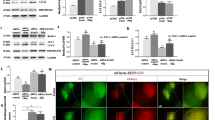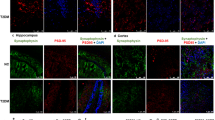Abstract
SGTB (Small glutamine-rich tetratricopeptide repeat (TPR)-containing, β) plays a critical role in protein–protein interactions. The interaction between SGTB and heat shock cognate protein (Hsc70)/heat shock protein (Hsp70) has aroused much attention in recent years. The present study was designed to elucidate dynamic changes in SGTB expression and distribution in the cerebral cortex in a lipopolysaccharide (LPS)-induced neuroinflammation rat model. It was found that SGTB expression was increased significantly in apoptotic neurons after LPS injection. The result of our in vitro study suggested that SGTB up-regulation might be associated with neuronal apoptosis after H2O2 challenge. In addition, silencing of SGTB in cultured PC12 (Pheochromocytoma) by siRNA indicated that SGTB was required for neuronal apoptosis induced by oxidative stress. Our finding about the cellular signal pathway may provide a new strategy against neuronal apoptosis in neuroinflammation in CNS.






Similar content being viewed by others
References
Adrain C, Martin SJ (2001) The mitochondrial apoptosome: a killer unleashed by the cytochrome seas. Trends Biochem Sci 26:390–397
Allaman I, Belanger M, Magistretti PJ (2011) Astrocyte-neuron metabolic relationships: for better and for worse. Trends Neurosci 34:76–87
Angeletti PC, Walker D, Panganiban AT (2002) Small glutamine-rich protein/viral protein U-binding protein is a novel cochaperone that affects heat shock protein 70 activity. Cell Stress Chaperones 7:258–268
Aschkenasy G, Bromberg Z, Raj N, Deutschman CS, Weiss YG (2011) Enhanced Hsp70 expression protects against acute lung injury by modulating apoptotic pathways. PLoS ONE 6:e26956
Beere HM, Wolf BB, Cain K, Mosser DD, Mahboubi A, Kuwana T, Tailor P, Morimoto RI, Cohen GM, Green DR (2000) Heat-shock protein 70 inhibits apoptosis by preventing recruitment of procaspase-9 to the Apaf-1 apoptosome. Nat Cell Biol 2:469–475
Block ML, Zecca L, Hong JS (2007) Microglia-mediated neurotoxicity: uncovering the molecular mechanisms. Nat Rev Neurosci 8:57–69
Bonow RH, Aid S, Zhang Y, Becker KG, Bosetti F (2009) The brain expression of genes involved in inflammatory response, the ribosome, and learning and memory is altered by centrally injected lipopolysaccharide in mice. Pharmacogenomics J 9:116–126
Callahan MA, Handley MA, Lee YH, Talbot KJ, Harper JW, Panganiban AT (1998) Functional interaction of human immunodeficiency virus type 1 Vpu and Gag with a novel member of the tetratricopeptide repeat protein family. J Virol 72:8461
Cao M, Zheng H, Tan X, Xu W, Rui Y, Li L, Liu X, Xu G, Cui G, Xu J, Cao J, Ke K, Wu Q (2013) Upregulation of CBLL1 in rat brain cortex after lipopolysaccharide treated. J Mol Histol 44:135–145
Cerbai F, Lana D, Nosi D, Petkova-Kirova P, Zecchi S, Brothers HM, Wenk GL, Giovannini MG (2012) The neuron-astrocyte-microglia triad in normal brain ageing and in a model of neuroinflammation in the rat hippocampus. PLoS ONE 7:e45250
Cziepluch C, Kordes E, Poirey R, Grewenig A, Rommelaere J, Jauniaux JC (1998) Identification of a novel cellular TPR-containing protein, SGT, that interacts with the nonstructural protein NS1 of parvovirus H-1. J Virol 72:4149–4156
D’Andrea LD, Regan L (2003) TPR proteins: the versatile helix. Trends Biochem Sci 28:655–662
Dantzer R, Kelley KW (2007) Twenty years of research on cytokine-induced sickness behavior. Brain Behav Immun 21:153–160
Fonte V, Kapulkin V, Taft A, Fluet A, Friedman D, Link CD (2002) Interaction of intracellular beta amyloid peptide with chaperone proteins. Proc Natl Acad Sci USA 99:9439–9444
Garrido C, Galluzzi L, Brunet M, Puig PE, Didelot C, Kroemer G (2006) Mechanisms of cytochrome c release from mitochondria. Cell Death Differ 13:1423–1433
Hauss-Wegrzyniak B, Dobrzanski P, Stoehr JD, Wenk GL (1998) Chronic neuroinflammation in rats reproduces components of the neurobiology of Alzheimer’s disease. Brain Res 780:294–303
Hein AM, O’Banion MK (2009) Neuroinflammation and memory: the role of prostaglandins. Mol Neurobiol 40:15–32
Li P, Nijhawan D, Budihardjo I, Srinivasula SM, Ahmad M, Alnemri ES, Wang X (1997) Cytochrome c and dATP-dependent formation of Apaf-1/caspase-9 complex initiates an apoptotic protease cascade. Cell 91:479–489
Li C, Zhao R, Gao K, Wei Z, Yin MY, Lau LT, Chui D, Hoi Yu AC (2011) Astrocytes: implications for neuroinflammatory pathogenesis of Alzheimer’s disease. Curr Alzheimer Res 8:67–80
Liraz-Zaltsman S, Alexandrovich AG, Trembovler V, Fishbein I, Yaka R, Shohami E, Biegon A (2011) Regional sensitivity to neuroinflammation: in vivo and in vitro studies. Synapse 65:634–642
Liu FH, Wu SJ, Hu SM, Hsiao CD, Wang C (1999) Specific interaction of the 70-kDa heat shock cognate protein with the tetratricopeptide repeats. J Biol Chem 274:34425–34432
Renton KW, Dibb S, Levatte TL (1999) Lipopolysaccharide evokes the modulation of brain cytochrome P4501A in the rat. Brain Res 842:139–147
Saleh A, Srinivasula SM, Balkir L, Robbins PD, Alnemri ES (2000) Negative regulation of the Apaf-1 apoptosome by Hsp70. Nat Cell Biol 2:476–483
Schantl JA, Roza M, De Jong AP, Strous GJ (2003) Small glutamine-rich tetratricopeptide repeat-containing protein (SGT) interacts with the ubiquitin-dependent endocytosis (UbE) motif of the growth hormone receptor. Biochem J 373:855–863
Sun B, Gao Y, Lou D, Wu X, Wei H, Wen H, Deng X, Zhang F (2013) Expression of G-protein-coupled receptor kinase 6 (GRK6) after acute spinal cord injury in adult rat. J Mol Histol 44:259–270
Tobaben S, Thakur P, Fernandez-Chacon R, Sudhof TC, Rettig J, Stahl B (2001) A trimeric protein complex functions as a synaptic chaperone machine. Neuron 31:987–999
Tobaben S, Varoqueaux F, Brose N, Stahl B, Meyer G (2003) A brain-specific isoform of small glutamine-rich tetratricopeptide repeat-containing protein binds to Hsc70 and the cysteine string protein. J Biol Chem 278:38376–38383
Wang H, Shen H, Wang Y, Li Z, Yin H, Zong H, Jiang J, Gu J (2005) Overexpression of small glutamine-rich TPR-containing protein promotes apoptosis in 7721 cells. FEBS Lett 579:1279–1284
Willard LB, Hauss-Wegrzyniak B, Danysz W, Wenk GL (2000) The cytotoxicity of chronic neuroinflammation upon basal forebrain cholinergic neurons of rats can be attenuated by glutamatergic antagonism or cyclooxygenase-2 inhibition. Exp Brain Res 134:58–65
Winnefeld M, Rommelaere J, Cziepluch C (2004) The human small glutamine-rich TPR-containing protein is required for progress through cell division. Exp Cell Res 293:43–57
Winnefeld M, Grewenig A, Schnolzer M, Spring H, Knoch TA, Gan EC, Rommelaere J, Cziepluch C (2006) Human SGT interacts with Bag-6/Bat-3/Scythe and cells with reduced levels of either protein display persistence of few misaligned chromosomes and mitotic arrest. Exp Cell Res 312:2500–2514
Worrall LJ, Wear MA, Page AP, Walkinshaw MD (2008) Cloning, purification and characterization of the Caenorhabditis elegans small glutamine-rich tetratricopeptide repeat-containing protein. Biochim Biophys Acta 1784:496–503
Wu SJ, Liu FH, Hu SM, Wang C (2001) Different combinations of the heat-shock cognate protein 70 (hsc70) C-terminal functional groups are utilized to interact with distinct tetratricopeptide repeat-containing proteins. Biochem J 359:419–426
Wu X, Li J, Chen C, Yan Y, Jiang S, Shao B, Xu J, Kang L, Huang Y, Zhu L, Ji Y, Gao Y (2012) Involvement of CLEC16A in activation of astrocytes after LPS treated. Neurochem Res 37:5–14
Yan Y, Tan X, Wu X, Shao B, Cao J, Xu J, Jin W, Li L, Xu W, Wang X, Gao Y, Cui G (2013) Involvement of early growth response-2 (Egr-2) in lipopolysaccharide-induced neuroinflammation. J Mol Histol 44:249–257
Yin H, Wang H, Zong H, Chen X, Wang Y, Yun X, Wu Y, Wang J, Gu J (2006) SGT, a Hsp90beta binding partner, is accumulated in the nucleus during cell apoptosis. Biochem Biophys Res Commun 343:1153–1158
Zhang G, Yan Y, Kang L, Cao Q, Ke K, Wu X, Gao Y, Hang Q, Li C, Zhu L, Yuan Q, Wu Q, Cheng C (2012) Involvement of CtBP2 in LPS-induced microglial activation. J Mol Histol 43:327–334
Acknowledgments
This study was supported by the National Natural Science Foundation of China (No. 21077061 and 81202368) and A Project Funded by the Priority Academic Program Development of Jiangsu Higher Education Institutions (PAPD).
Author information
Authors and Affiliations
Corresponding authors
Additional information
Maohong Cao, Wei Xu and Jian Yu contributed equally to this work.
Rights and permissions
About this article
Cite this article
Cao, M., Xu, W., Yu, J. et al. Up-regulation of SGTB is associated with neuronal apoptosis after neuroinflammation induced by lipopolysaccharide. J Mol Hist 44, 507–518 (2013). https://doi.org/10.1007/s10735-013-9517-4
Received:
Accepted:
Published:
Issue Date:
DOI: https://doi.org/10.1007/s10735-013-9517-4




